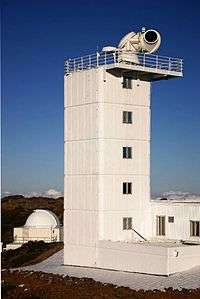Solar telescope
A solar telescope is a special purpose telescope used to observe the Sun. Solar telescopes usually detect light with wavelengths in, or not far outside, the visible spectrum. Heliograph is a historical, now deprecated term, for it.
Professional solar telescopes
Solar telescopes need optics large enough to achieve the best possible diffraction limit but less so for the associated light-collecting power of other astronomical telescopes. However, recently newer narrower filters and higher framerates have also driven solar telescopes towards photon-starved operations.[1] Both the European Solar Telescope as well as the Advanced Technology Solar Telescope have larger apertures not only to increase the resolution, but also to increase the light-collecting power.
Because solar telescopes operate during the day, seeing is generally worse than for night-time telescopes, because the ground around the telescope is heated which causes turbulence and degrades the resolution. To alleviate this, solar telescopes are usually built on towers and the structures are painted white. The Dutch Open Telescope is built on an open framework to allow the wind to pass through the complete structure and provide cooling around the telescope's main mirror.
Another solar telescope-specific problem is the heat generated by the tightly-focused sunlight. For this reason, a heat stop is an integral part of the design of solar telescopes. For the upcoming ATST, the heat load is 2.5 MW/m2, with peak powers of 11.4 kW.[2] The goal of such a heat stop is not only to survive this heat load, but also to remain cool enough not to induce any additional turbulence inside the telescope's dome.
Professional solar observatories may have main optical elements with very long focal lengths (although not always, Dutch Open Telescope) and light paths operating in a vacuum or helium to eliminate air motion due to convection inside the telescope. However, this is not possible for apertures over 1 meter, at which the pressure difference at the entrance window of the vacuum tube becomes too large. Therefore, the EST and ATST have active cooling of the dome to minimize the temperature difference between the air inside and outside the telescope.
Because the Sun travels on a narrow fixed path across the sky, some solar telescopes are fixed in position (and are sometimes buried underground), with the only moving part being a heliostat to track the Sun. One example of this is the McMath-Pierce Solar Telescope.
Selected solar telescopes
See also List of solar telescopes
- The Einstein Tower (Einsteinturm) became operational in 1924
- McMath-Pierce Solar Telescope (1.6 m diameter, 1961–)
- McMath-Hulbert Observatory (24"/61 cm diameter, 1941–1979)
- Swedish Vacuum Solar Telescope (47.5 cm diameter, 1985–2000)
- Swedish 1-m Solar Telescope (1 m diameter, 2002–)
- Richard B. Dunn Solar Telescope (1.63 m diameter, 1969–)
- Mount Wilson Observatory
- Dutch Open Telescope (45 cm diameter, 1997–)
- The Teide Observatory hosts multiple solar telescopes, including
- the 70 cm Vacuum Tower Telescope (1989–) and
- the 1.5 m GREGOR Solar Telescope nearing completion (as of 2007, webcam).
- Advanced Technology Solar Telescope, a planned telescope with 4m aperture.
- European Solar Telescope, a future 4-meter class aperture telescope.
- National Large Solar Telescope (NLST), is a Gregorian multi-purpose open telescope proposed to be built and Installed in India and aims to study the sun's microscopic structure.
Other types of observation
Most solar observatories observe optically at visible, UV, and near infrared wavelengths, but other solar phenomena can be observed — albeit not from the Earth's surface due to the absorption of the atmosphere:
- Solar X-ray astronomy, observations of the Sun in x-rays
- Multi-spectral solar telescope array (MSSTA), a rocket launched payload of UV telescopes in the 1990s
- Leoncito Astronomical Complex operated a submillimeter wavelength solar telescope.
- The Radio Solar Telescope Network (RSTN) is a network of solar observatories maintained and operated by the U.S. Air Force Weather Agency.
- CERN Axion Solar Telescope(CAST), looks for solar axions in the early 2000s
Amateur solar telescopes

In the field of amateur astronomy there are many methods used to observe the sun. Amateurs use everything from simple systems to project the sun on a piece of white paper, light blocking filters, Herschel wedges which redirect 95% of the light away from the eyepiece,[3] up to hydrogen-alpha filter systems and even home built spectrohelioscopes. In contrast to professional telescopes, amateur solar telescopes are usually much smaller.

See also
References
- ↑ Stenflo, J. O. (2001). G. Mathys; S. K. Solanki; D. T. Wickramasinghe, eds. "Limitations and Opportunities for the Diagnostics of Solar and Stellar Magnetic Fields". ASP Conference Proceedings. Magnetic Fields Across the Hertzsprung-Russell Diagram (San Francisco: Astronomical Society of the Pacific) 248: 639. Bibcode:2001ASPC..248..639S.
- ↑ Dalrymple (1 April 2003). "Heat Stop Concepts" (PDF). ATST Technical Notes.
- ↑ Pierre Guillermier, Serge Koutchmy, Total eclipses: science, observations, myths, and legends, page 37
External links
| Look up solar telescope in Wiktionary, the free dictionary. |
- Solar telescopes, Wolfgang Schmidt, Scholarpedia,3(4):4333. doi:10.4249/scholarpedia.4333
- CSIRO Solar Heliograph part 2
- Solar Gallery of an amateur astronomer
- Solar Gallery of the Hong Kong Astronomical Society
- Lawrence, Pete. "Solar Observing (Part I)". Deep Sky Videos. Brady Haran.
| ||||||||||||||||||||||||
| |||||||||||||||||||||||||||||||||||||||



